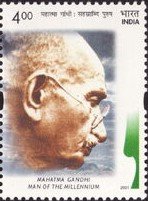Men of the Millennium – Mahatma Gandhi (1869-1948)

Technical Data
| Stamp Set | Mahatma Gandhi Memorial |
|---|---|
| Date of Issue | October 2, 2001 |
| Denomination | Rs. 4 |
| Quantity | 3,000,000 |
| Perforation | comb 13 |
| Printer | Calcutta Security Printers Ltd |
| Watermark | No Watermark |
| Colors | Multicolor |
| Catalog Codes |
Michel IN 1857 Stamp Number IN 1915b Yvert et Tellier IN 1621A Stanley Gibbons IN 2022 |
| Themes | Famous people | Freedom Fighters | Lawyers-Advocates | Men | Optical Instruments | Teachers |
Commemorative Stamp Set: Men of the Millennium – Mahatma Gandhi (1869-1948)
Table of Contents
Design Elements:
- The main image is a dignified portrayal of Mahatma Gandhi, seated in a meditative posture, symbolizing his dedication to truth and non-violence. He is shown spinning the charkha (spinning wheel), representing his commitment to self-reliance and rural empowerment.
- A golden aura surrounds him, signifying his influence and legacy across time.
- In the background, iconic scenes from Gandhi’s life, such as the Salt March, Quit India Movement, and his time in South Africa, are faintly sketched, connecting his personal journey with India’s fight for freedom.
- The text “Men of the Millennium” is inscribed above, with “Mahatma Gandhi 1869-1948” at the bottom in elegant lettering.
Cultural and Historical Significance:
- Mahatma Gandhi’s life and principles shaped the course of modern India and inspired global movements for civil rights and freedom. His philosophy of Satyagraha (truth-force) and non-violent resistance brought millions of Indians together in the struggle against British colonialism.
- Gandhi’s leadership in key events such as the Salt March, the Quit India Movement, and the fight against apartheid in South Africa left an indelible mark on the history of the 20th century.
- His commitment to self-sufficiency, symbolized by the spinning of the charkha, aimed to restore dignity to rural India, helping it break free from economic exploitation.
Usage:
- This commemorative stamp set will be issued to mark Gandhi Jayanti, the International Day of Non-Violence, and key events linked to human rights and peace movements worldwide.
- The stamp will serve as an educational tool in schools, universities, and institutions, encouraging discussions on non-violence, peace, and Gandhi’s enduring legacy.
Importance of the Commemorative Stamp Set:
- Declaring Gandhi as one of the “Men of the Millennium” emphasizes his unparalleled contributions to the principles of non-violence and human dignity, making his teachings relevant even today.
- This set highlights Gandhi’s influence on global movements for civil rights, equality, and justice, reinforcing his legacy not only as India’s Father of the Nation but as a world leader in peaceful resistance.
- The stamp serves as a powerful reminder of Gandhi’s belief that change can be achieved through moral courage, truth, and non-violent action.
Example of the Stamp Design:
The central image of Gandhi at the spinning wheel is timeless and profound, underscoring his belief in self-reliance and simplicity. Behind him, a faint backdrop of the Salt March, Quit India Movement, and the South African protests weaves together key chapters of his life, illustrating his leadership at home and abroad. The “Men of the Millennium” title crowns the image, with his birth and death years framed below in a classic font.
The commemorative stamp set might include:
- Main Stamp: Gandhi spinning the charkha, symbolizing self-reliance and non-violence.
- Supporting Stamps:
- Gandhi leading the Salt March, a historic act of civil disobedience.
- Gandhi with key global leaders such as Martin Luther King Jr. and Nelson Mandela, showing his international impact.
- Gandhi addressing the masses, emphasizing his role as a unifier of people across class, caste, and region.
Significance:
The “Men of the Millennium” commemorative stamp set honors Gandhi as a symbol of peace, justice, and equality. His philosophy of non-violent resistance reshaped India’s destiny and resonated across the globe, inspiring leaders and movements far beyond his lifetime. By highlighting the major moments of his life and his global influence, the stamp set not only commemorates a historical figure but also reinforces Gandhi’s teachings as timeless principles for building a just and harmonious world.
